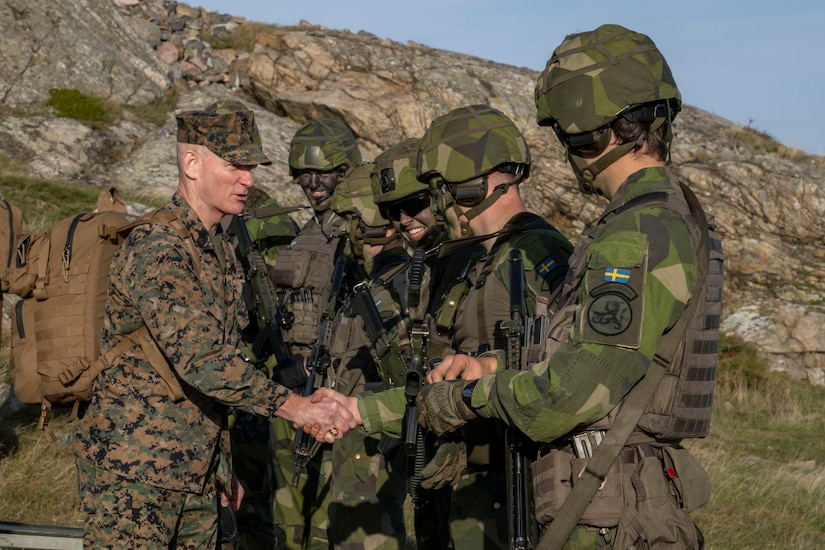Senior Enlisted Advisor to the Chairman Troy E. Black visited Sweden, Oct. 21-24.
The purpose of the visit was to connect with Black’s Swedish counterpart, Command Sgt. Maj. Johan Lindgren, Swedish Armed Forces Command senior enlisted leader and enlisted advisor for the Swedish Armed Forces supreme commander, to discuss the Swedish noncommissioned officer corps, the U.S.-Swedish Defense Cooperation Agreement as a recent ally of NATO and to get a firsthand look at Sweden’s increasing defense capabilities.
Black toured the Swedish Air Defense Regiment in Halmstad, Sweden, and the Älvsborg Marine Regiment in Gothenburg, Sweden.
Command Sgt. Maj. Fredrik Finer, Swedish Air Defense Regiment command sergeant major, welcomed Black to the Halmstad Garrison, providing a presentation of the military base’s operations. Other key players delved further into the basic training system for conscripts, or compulsorily enlisted members, professional soldiers, NCOs and officers. Many of the approximately 1,500 members stationed at Halmstad’s Air Defense Regiment attend Sweden’s largest Armed Forces Technical School.
During the briefing, Black learned about Sweden’s growing air defense and training capabilities. The Halmstad Garrison is integral to training Swedish armed forces members through the basic training battalion. Moreover, Halmstad’s Air Defense Battalion maintains order and readiness in addition to supporting new air defense units and the air defense schoolhouse with education and development of service members. A large part of sustaining this support originates from fully integrating existing Swedish operations systems with NATO air and missile defense systems, contributing to building an even stronger force, both within Sweden and NATO.
Moreover, Halmstad is a strategic location for developing host nation support, especially for domestic defense. Due to its geographical location, Halmstad is a logistical hub and has provided host nation support since 2017 for reception, staging, onward movement, and now, integration with other NATO forces. This host nation support builds upon the U.S.-Swedish DCA, which went into effect on Aug. 15, 2024, and paves the way for closer cooperation bilaterally and within the framework of NATO. The DCA regulates the conditions for U.S. forces to operate in Sweden such as the legal status of U.S. personnel and access to military areas.
Additionally, Black was given a tour of the regiment’s NCO academy and spoke to students in the higher NCO course, providing an opportunity for a question-and-answer session. The discussion primarily focused on the importance of developing and training personnel through professional military education — ensuring readiness for future conflicts. Black also highlighted the need to build up organizations for future challenges from a U.S. perspective.
Along with the importance of the Air Defense Regiment, the Älvsborg Marine Regiment in Gothenburg is another strategic location on Sweden’s west coast. Hosted at the Älvsborg Marine Regiment by Swedish Armed Forces Col. Fredrik Herlitz, Älvsborg Marine Regiment communicating officer, and Command Sgt. Maj. Mats Afzelius, Älvsborg Marine Regiment command sergeant major, Black was given an overview of the regiment’s mission prior to the tour of the archipelago. He also discussed the roles and responsibilities of NCOs and how these responsibilities have changed in recent years.
Black explained that officers are delegating decision-making to NCOs while officers can oversee an entire operation.
“There is much you can learn from counter narcotics on how to delegate, and the NCO is providing decisions in complex environments,” he said. “That’s where I see this partnership working the best. It’s an amazing thing to see the transformation and why the Swedish military in particular has gone back to the NCO corps — because the environment has changed. Although the U.S. military has always had an NCO corps, the roles and responsibilities have not always been what they are today. They expanded because officer roles have expanded as well.”
With about 900 members assigned to the 5th Marine Battalion and the 17th Under Surface Warfare Company, the Swedish Marines provide amphibious high mobility, expeditionary and interoperable support.
Marines assigned to the Älvsborg Marine Regiment provided a demonstration of their amphibious battalion abilities with an amphibious landing, deploying a Robot 17 antiship missile and an 8-centimeter mortar.
The tour ended with a final meeting with Herlitz and Afzelius to discuss the overall visit and opportunities for further cooperation. Additionally, Black gathered with about 100 Swedish Marines at the regiment, who asked questions about the evolution of warfare, emphasizing the importance of adapting to new domains, the necessity for modernization and innovation, and circled back to the roles of NCOs and officers in leadership.
Overall, Black’s visit with Swedish counterparts emphasized the importance of fostering growth among allies and partners, not just bilaterally, but within NATO as a whole, and the significance of building up the NCO corps to become a more lethal, effective force when it comes to warfighting.







